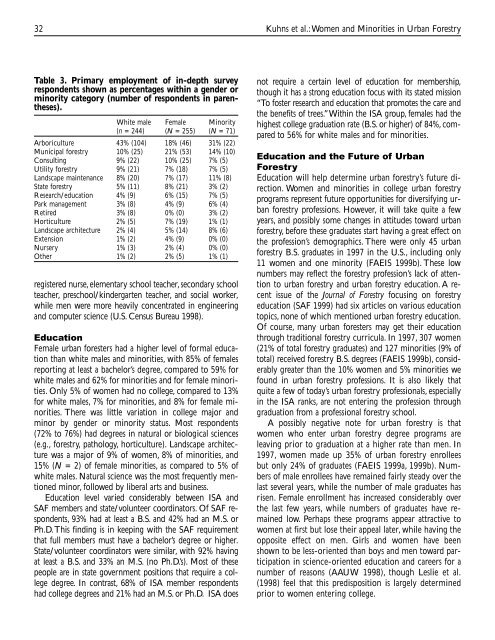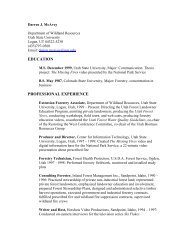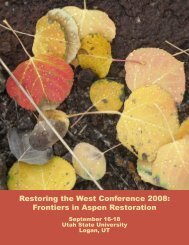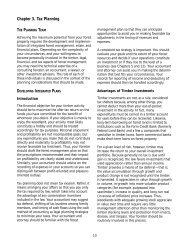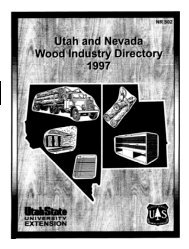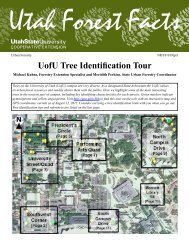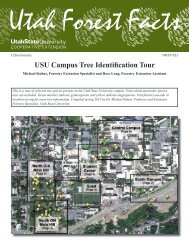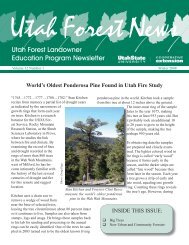involvement of women and minorities in the urban forestry ... - TreeLink
involvement of women and minorities in the urban forestry ... - TreeLink
involvement of women and minorities in the urban forestry ... - TreeLink
Create successful ePaper yourself
Turn your PDF publications into a flip-book with our unique Google optimized e-Paper software.
32 Kuhns et al.: Women <strong>and</strong> M<strong>in</strong>orities <strong>in</strong> Urban Forestry<br />
Table 3. Primary employment <strong>of</strong> <strong>in</strong>-depth survey<br />
respondents shown as percentages with<strong>in</strong> a gender or<br />
m<strong>in</strong>ority category (number <strong>of</strong> respondents <strong>in</strong> paren<strong>the</strong>ses).<br />
White male Female M<strong>in</strong>ority<br />
(n = 244) (N = 255) (N = 71)<br />
Arboriculture 43% (104) 18% (46) 31% (22)<br />
Municipal <strong>forestry</strong> 10% (25) 21% (53) 14% (10)<br />
Consult<strong>in</strong>g 9% (22) 10% (25) 7% (5)<br />
Utility <strong>forestry</strong> 9% (21) 7% (18) 7% (5)<br />
L<strong>and</strong>scape ma<strong>in</strong>tenance 8% (20) 7% (17) 11% (8)<br />
State <strong>forestry</strong> 5% (11) 8% (21) 3% (2)<br />
Research/education 4% (9) 6% (15) 7% (5)<br />
Park management 3% (8) 4% (9) 6% (4)<br />
Retired 3% (8) 0% (0) 3% (2)<br />
Horticulture 2% (5) 7% (19) 1% (1)<br />
L<strong>and</strong>scape architecture 2% (4) 5% (14) 8% (6)<br />
Extension 1% (2) 4% (9) 0% (0)<br />
Nursery 1% (3) 2% (4) 0% (0)<br />
O<strong>the</strong>r 1% (2) 2% (5) 1% (1)<br />
registered nurse, elementary school teacher, secondary school<br />
teacher, preschool/k<strong>in</strong>dergarten teacher, <strong>and</strong> social worker,<br />
while men were more heavily concentrated <strong>in</strong> eng<strong>in</strong>eer<strong>in</strong>g<br />
<strong>and</strong> computer science (U.S. Census Bureau 1998).<br />
Education<br />
Female <strong>urban</strong> foresters had a higher level <strong>of</strong> formal education<br />
than white males <strong>and</strong> <strong>m<strong>in</strong>orities</strong>, with 85% <strong>of</strong> females<br />
report<strong>in</strong>g at least a bachelor’s degree, compared to 59% for<br />
white males <strong>and</strong> 62% for <strong>m<strong>in</strong>orities</strong> <strong>and</strong> for female <strong>m<strong>in</strong>orities</strong>.<br />
Only 5% <strong>of</strong> <strong>women</strong> had no college, compared to 13%<br />
for white males, 7% for <strong>m<strong>in</strong>orities</strong>, <strong>and</strong> 8% for female <strong>m<strong>in</strong>orities</strong>.<br />
There was little variation <strong>in</strong> college major <strong>and</strong><br />
m<strong>in</strong>or by gender or m<strong>in</strong>ority status. Most respondents<br />
(72% to 76%) had degrees <strong>in</strong> natural or biological sciences<br />
(e.g., <strong>forestry</strong>, pathology, horticulture). L<strong>and</strong>scape architecture<br />
was a major <strong>of</strong> 9% <strong>of</strong> <strong>women</strong>, 8% <strong>of</strong> <strong>m<strong>in</strong>orities</strong>, <strong>and</strong><br />
15% (N = 2) <strong>of</strong> female <strong>m<strong>in</strong>orities</strong>, as compared to 5% <strong>of</strong><br />
white males. Natural science was <strong>the</strong> most frequently mentioned<br />
m<strong>in</strong>or, followed by liberal arts <strong>and</strong> bus<strong>in</strong>ess.<br />
Education level varied considerably between ISA <strong>and</strong><br />
SAF members <strong>and</strong> state/volunteer coord<strong>in</strong>ators. Of SAF respondents,<br />
93% had at least a B.S. <strong>and</strong> 42% had an M.S. or<br />
Ph.D. This f<strong>in</strong>d<strong>in</strong>g is <strong>in</strong> keep<strong>in</strong>g with <strong>the</strong> SAF requirement<br />
that full members must have a bachelor’s degree or higher.<br />
State/volunteer coord<strong>in</strong>ators were similar, with 92% hav<strong>in</strong>g<br />
at least a B.S. <strong>and</strong> 33% an M.S. (no Ph.D.’s). Most <strong>of</strong> <strong>the</strong>se<br />
people are <strong>in</strong> state government positions that require a college<br />
degree. In contrast, 68% <strong>of</strong> ISA member respondents<br />
had college degrees <strong>and</strong> 21% had an M.S. or Ph.D. ISA does<br />
not require a certa<strong>in</strong> level <strong>of</strong> education for membership,<br />
though it has a strong education focus with its stated mission<br />
“To foster research <strong>and</strong> education that promotes <strong>the</strong> care <strong>and</strong><br />
<strong>the</strong> benefits <strong>of</strong> trees.” With<strong>in</strong> <strong>the</strong> ISA group, females had <strong>the</strong><br />
highest college graduation rate (B.S. or higher) <strong>of</strong> 84%, compared<br />
to 56% for white males <strong>and</strong> for <strong>m<strong>in</strong>orities</strong>.<br />
Education <strong>and</strong> <strong>the</strong> Future <strong>of</strong> Urban<br />
Forestry<br />
Education will help determ<strong>in</strong>e <strong>urban</strong> <strong>forestry</strong>’s future direction.<br />
Women <strong>and</strong> <strong>m<strong>in</strong>orities</strong> <strong>in</strong> college <strong>urban</strong> <strong>forestry</strong><br />
programs represent future opportunities for diversify<strong>in</strong>g <strong>urban</strong><br />
<strong>forestry</strong> pr<strong>of</strong>essions. However, it will take quite a few<br />
years, <strong>and</strong> possibly some changes <strong>in</strong> attitudes toward <strong>urban</strong><br />
<strong>forestry</strong>, before <strong>the</strong>se graduates start hav<strong>in</strong>g a great effect on<br />
<strong>the</strong> pr<strong>of</strong>ession’s demographics. There were only 45 <strong>urban</strong><br />
<strong>forestry</strong> B.S. graduates <strong>in</strong> 1997 <strong>in</strong> <strong>the</strong> U.S., <strong>in</strong>clud<strong>in</strong>g only<br />
11 <strong>women</strong> <strong>and</strong> one m<strong>in</strong>ority (FAEIS 1999b). These low<br />
numbers may reflect <strong>the</strong> <strong>forestry</strong> pr<strong>of</strong>ession’s lack <strong>of</strong> attention<br />
to <strong>urban</strong> <strong>forestry</strong> <strong>and</strong> <strong>urban</strong> <strong>forestry</strong> education. A recent<br />
issue <strong>of</strong> <strong>the</strong> Journal <strong>of</strong> Forestry focus<strong>in</strong>g on <strong>forestry</strong><br />
education (SAF 1999) had six articles on various education<br />
topics, none <strong>of</strong> which mentioned <strong>urban</strong> <strong>forestry</strong> education.<br />
Of course, many <strong>urban</strong> foresters may get <strong>the</strong>ir education<br />
through traditional <strong>forestry</strong> curricula. In 1997, 307 <strong>women</strong><br />
(21% <strong>of</strong> total <strong>forestry</strong> graduates) <strong>and</strong> 127 <strong>m<strong>in</strong>orities</strong> (9% <strong>of</strong><br />
total) received <strong>forestry</strong> B.S. degrees (FAEIS 1999b), considerably<br />
greater than <strong>the</strong> 10% <strong>women</strong> <strong>and</strong> 5% <strong>m<strong>in</strong>orities</strong> we<br />
found <strong>in</strong> <strong>urban</strong> <strong>forestry</strong> pr<strong>of</strong>essions. It is also likely that<br />
quite a few <strong>of</strong> today’s <strong>urban</strong> <strong>forestry</strong> pr<strong>of</strong>essionals, especially<br />
<strong>in</strong> <strong>the</strong> ISA ranks, are not enter<strong>in</strong>g <strong>the</strong> pr<strong>of</strong>ession through<br />
graduation from a pr<strong>of</strong>essional <strong>forestry</strong> school.<br />
A possibly negative note for <strong>urban</strong> <strong>forestry</strong> is that<br />
<strong>women</strong> who enter <strong>urban</strong> <strong>forestry</strong> degree programs are<br />
leav<strong>in</strong>g prior to graduation at a higher rate than men. In<br />
1997, <strong>women</strong> made up 35% <strong>of</strong> <strong>urban</strong> <strong>forestry</strong> enrollees<br />
but only 24% <strong>of</strong> graduates (FAEIS 1999a, 1999b). Numbers<br />
<strong>of</strong> male enrollees have rema<strong>in</strong>ed fairly steady over <strong>the</strong><br />
last several years, while <strong>the</strong> number <strong>of</strong> male graduates has<br />
risen. Female enrollment has <strong>in</strong>creased considerably over<br />
<strong>the</strong> last few years, while numbers <strong>of</strong> graduates have rema<strong>in</strong>ed<br />
low. Perhaps <strong>the</strong>se programs appear attractive to<br />
<strong>women</strong> at first but lose <strong>the</strong>ir appeal later, while hav<strong>in</strong>g <strong>the</strong><br />
opposite effect on men. Girls <strong>and</strong> <strong>women</strong> have been<br />
shown to be less-oriented than boys <strong>and</strong> men toward participation<br />
<strong>in</strong> science-oriented education <strong>and</strong> careers for a<br />
number <strong>of</strong> reasons (AAUW 1998), though Leslie et al.<br />
(1998) feel that this predisposition is largely determ<strong>in</strong>ed<br />
prior to <strong>women</strong> enter<strong>in</strong>g college.


